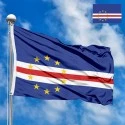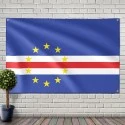The national flag of the Republic of Cabo Verde (Cape Verde) is a striking and profoundly symbolic representation of the island nation's unique identity, its journey to independence, and its enduring aspirations. Adopted on September 25, 1992, it replaced an older flag that more closely mirrored the colors and symbolism of Guinea-Bissau, reflecting a deliberate shift towards a distinct national identity separate from its former political union. This vibrant banner tells a story of an archipelago's connection to the sea, its people's unity, and their hopeful gaze towards the future.
Design and Symbolism: A Sea of Hope and a Path to the Future
The flag of Cabo Verde is characterized by a deep blue field, upon which are placed three horizontal stripes – a white stripe, a red stripe, and another white stripe – positioned below the center. Above these stripes, a circle of ten yellow stars is arranged, symbolizing the islands. Each element of the flag is rich with meaning:
-
Deep Blue Field: The predominant deep blue color of the flag is highly significant, representing the vast Atlantic Ocean that surrounds the archipelago of Cabo Verde. It symbolizes the sea as the nation's lifeblood, providing sustenance, connecting the islands, and acting as a pathway to the wider world. Beyond its literal meaning, the blue also denotes peace and tranquility, fundamental values for the nation. It reflects the boundless sky and the serene environment that envelops the islands.
-
White Stripe (Upper): The upper white stripe, thinner than the blue field but thicker than the red, symbolizes peace. It represents the desire of the Cape Verdean people for harmony, stability, and a future free from conflict. It also alludes to the clear, unclouded skies over the islands.
-
Red Stripe (Middle): The central red stripe, the narrowest of the three horizontal bands, represents the effort and struggle of the Cape Verdean people to build the nation. It symbolizes perseverance, hard work, and the blood shed during the fight for independence. It is a powerful reminder of the sacrifices made to achieve sovereignty and the ongoing commitment to national development.
-
White Stripe (Lower): The lower white stripe, identical in width to the upper one, symbolizes hope. It speaks to the optimistic outlook of the people, their belief in a brighter future, and their aspirations for progress and prosperity. Together, the white-red-white sequence of stripes can be interpreted as a pathway or bridge, indicating the nation's journey forward.
-
Ten Yellow Stars: The circle of ten five-pointed yellow stars is arguably the most distinctive and poignant element of the flag. Each star represents one of the ten main inhabited islands that constitute the archipelago of Cabo Verde: Santo Antão, São Vicente, Santa Luzia (uninhabited, but traditionally counted), São Nicolau, Sal, Boa Vista, Maio, Santiago, Fogo, and Brava.
-
Unity: The circular arrangement of the stars symbolizes unity and national cohesion. It signifies that all the islands are interconnected and contribute to the whole, working together for the common good.
-
Guidance and Light: Yellow, the color of the stars, symbolizes vitality, sun, and light. The stars themselves represent a guiding light for the nation, illuminating its path towards progress and development. They are beacons of optimism and a reminder of the unique identity of each island within the unified nation.
-
Nation's Destiny: The stars are also seen as marking the nation's destiny and its place in the world, emerging from the vastness of the ocean.
The combined symbolism tells a narrative of a peaceful nation (blue, white) that achieved its sovereignty through struggle (red) and is now united (circle of stars) in its hope for a bright, prosperous future, with each island playing its part (ten stars).
Dimensions and Proportions:
The official proportions of the Flag of Cabo Verde are a width-to-length ratio of 10:17. This is a specific and somewhat unusual ratio, distinguishing it from the more common 2:3 or 1:2 ratios found in many national flags. The three horizontal stripes (white, red, white) are positioned in the lower half of the flag, creating a larger blue field above them. The exact positioning and dimensions of the stripes and the circle of stars are precisely defined in the country's heraldic specifications to ensure uniformity and accuracy in reproduction. The overall design occupies the entire flag, with the blue dominating the top two-thirds, and the stripes and stars occupying the lower third.
History and Evolution: From Shared Identity to Distinct Nationhood
The history of the Cabo Verdean flag is inextricably linked to its colonial past and its post-independence political trajectory.
-
Portuguese Colonial Rule: For centuries, Cabo Verde was a Portuguese colony. During this period, the official flag was the flag of Portugal. There was no distinct colonial flag for the archipelago.
-
Post-Independence (1975-1992): Upon gaining independence from Portugal on July 5, 1975, Cabo Verde adopted a flag that was very similar to that of Guinea-Bissau. This was due to the shared liberation movement, the African Party for the Independence of Guinea and Cape Verde (PAIGC), which envisioned a political union between the two territories. The 1975 flag featured:
-
A vertical red stripe at the hoist, bearing a black star (representing African unity and the PAIGC).
-
Two horizontal stripes: yellow on top and green on the bottom.
-
Red: Symbolized the struggle for independence.
-
Green: Represented the lush nature and hope.
-
Yellow: Stood for the sun and the wealth of the country.
-
Black Star: Represented African unity and the guiding light for both nations. This flag reflected the strong political and ideological ties between Cabo Verde and Guinea-Bissau, both liberated by the PAIGC.
-
Shift to a New Identity (1992-Present): However, the proposed union between Cabo Verde and Guinea-Bissau never materialized, and political changes in both countries led to a divergence of paths. In Cabo Verde, with the transition to a multi-party democracy in the early 1990s and a desire to forge a distinct national identity, a new flag was adopted on September 25, 1992. This new flag, the current one, intentionally broke away from the Pan-African colors (red, green, yellow) and the black star of the PAIGC flag, which were seen as symbols of the former ruling party rather than the entire nation. The new design emphasized the archipelago's unique maritime character, its democratic values, and its forward-looking aspirations. The 1992 flag marked a clear departure from the past, embracing a future independent of previous political affiliations and focusing purely on the unique identity and destiny of Cabo Verde.
Regional Context and Island Nation Identity:
Cabo Verde is an archipelago nation located in the central Atlantic Ocean, off the coast of West Africa. It comprises ten volcanic islands, nine of which are inhabited, and several islets. Despite its geographical proximity to West Africa, its island nature and distinct history have shaped a unique identity, often influenced by European (especially Portuguese) and African cultures.
The flag’s design, particularly its dominant blue field and the emphasis on the ten stars, firmly establishes Cabo Verde’s identity as an island nation deeply connected to the sea. Unlike many other African flags that primarily use Pan-African colors to signify continental solidarity, Cabo Verde's flag deliberately chose colors (blue, white, red, yellow stars) and symbolism that reflect its unique maritime geography and its specific path to independence and development. While it maintains a connection to African solidarity through its historical struggle (red), its primary focus is on its insular nature, the unity of its islands, and its peaceful aspirations. This distinguishes it from its mainland African counterparts and highlights its distinct character within the broader African continent and the Atlantic community. The flag is a powerful visual statement of its unique island identity and its strategic position in the Atlantic.
Interesting Facts:
-
Distinct from Pan-African Colors: Cabo Verde's current flag notably does not primarily feature the traditional Pan-African colors (red, green, yellow) prevalent in many African flags. This was a deliberate choice to symbolize a break from its post-independence political union with Guinea-Bissau and to assert a unique national identity.
-
"Ship of Stars": The arrangement of the ten yellow stars in a circle against the blue background is sometimes metaphorically referred to as a "ship of stars" sailing on the ocean, symbolizing the nation's journey and destiny.
-
Ten Islands: Each of the ten stars represents one of the ten main islands of the archipelago, including Santa Luzia, which is uninhabited but traditionally counted among the major islands.
-
Official Adoption Date: The flag was adopted on September 25, 1992, replacing a previous flag that strongly resembled Guinea-Bissau's, symbolizing a clear shift in national identity and political direction.
-
Maritime Identity: The dominant blue color emphasizes Cabo Verde's strong connection to the Atlantic Ocean, its primary source of livelihood and its link to the world.
-
No Coat of Arms: Unlike some flags that incorporate a coat of arms, the flag of Cabo Verde is a purely vexillological design, with its symbols directly integrated into the flag itself.
-
Democratic Transition: The adoption of the new flag coincided with Cabo Verde's transition to a multi-party democracy, signifying a new era for the nation.
-
Meaning of Red Stripe: The red stripe, though narrow, is crucial, representing the effort and struggle of the people, a testament to their resilience and hard work in nation-building.
-
Circular Arrangement: The circular arrangement of the stars signifies unity and the equal importance of all islands within the archipelago.
-
Peace and Hope: The white stripes directly symbolize peace and hope, reflecting the aspirations of the Cape Verdean people for a harmonious and prosperous future.
Significance for the Inhabitants: A Beacon of Unity, Resilience, and Future Aspirations
For the people of Cabo Verde, their national flag is far more than a mere national emblem; it is a profound and cherished symbol that encapsulates their collective history, their unique identity as an island nation, and their deep-seated aspirations. It evokes a strong sense of patriotism, unity, and hope, serving as a constant reminder of their journey from colonial rule to a vibrant, independent democracy.
The expansive deep blue field of the flag resonates deeply with every Cape Verdean, symbolizing their inextricable link to the Atlantic Ocean. This ocean is not just their home; it is their lifeline, a source of sustenance, a highway for trade, and a connection to their diaspora scattered across the globe. The blue also represents the peace and tranquility that the islanders value, a reflection of their serene environment and their desire for harmony. It instills a sense of belonging to a unique maritime culture.
The white and red stripes, weaving across the blue, tell a powerful story of perseverance and hope. The narrow red stripe serves as a poignant reminder of the struggles and sacrifices made to achieve independence and to build the nation. It honors the resilience and hard work of their ancestors and their own ongoing efforts in nation-building. The surrounding white stripes, symbolizing peace and hope, beautifully convey the optimistic spirit of the Cape Verdean people. They embody the belief that despite challenges, a peaceful and prosperous future is attainable through collective effort and unity. This sequence of colors emphasizes a forward trajectory, a path of progress.
The ten yellow stars, arranged in a vibrant circle, are perhaps the most emotionally resonant element for the inhabitants. Each star is a direct representation of their home island, creating an immediate and personal connection to the flag. The circular formation profoundly symbolizes the unity of the archipelago – that despite the geographical separation, all islands and their people are interconnected and equally vital to the nation's fabric. It reinforces the idea that together, they are stronger, guiding each other towards a shared destiny. The yellow color of the stars, signifying vitality and light, serves as a beacon of optimism, a reminder that the nation is always moving towards a brighter future, illuminated by the collective spirit of its islands.
The adoption of this specific flag in 1992 also holds significant meaning. It represented a deliberate choice to move beyond historical political affiliations and embrace a distinct national identity focused on the unique characteristics of Cabo Verde. For the people, this transition symbolized a reaffirmation of their democratic values and their commitment to self-determination.
Displayed with immense pride during national celebrations, cultural events, and in everyday life, the Flag of Cabo Verde acts as a powerful unifying force. It transcends local island distinctions, reminding all Cape Verdeans that they are part of one proud nation, sailing together on the vast ocean towards a future of peace, prosperity, and enduring unity. It truly embodies the spirit of a resilient people who look to the sea for their livelihood and to the stars for their guidance.
In the demonstration images, full-size flags are shown with proportions of 2:3, and hand-held flags with proportions of 1:2.






 Waving flag
Waving flag
 Sizes:
Sizes:
 Round flag
Round flag
 Sizes:
Sizes:
 Rectangular flag 2:3
Rectangular flag 2:3
 Sizes:
Sizes: